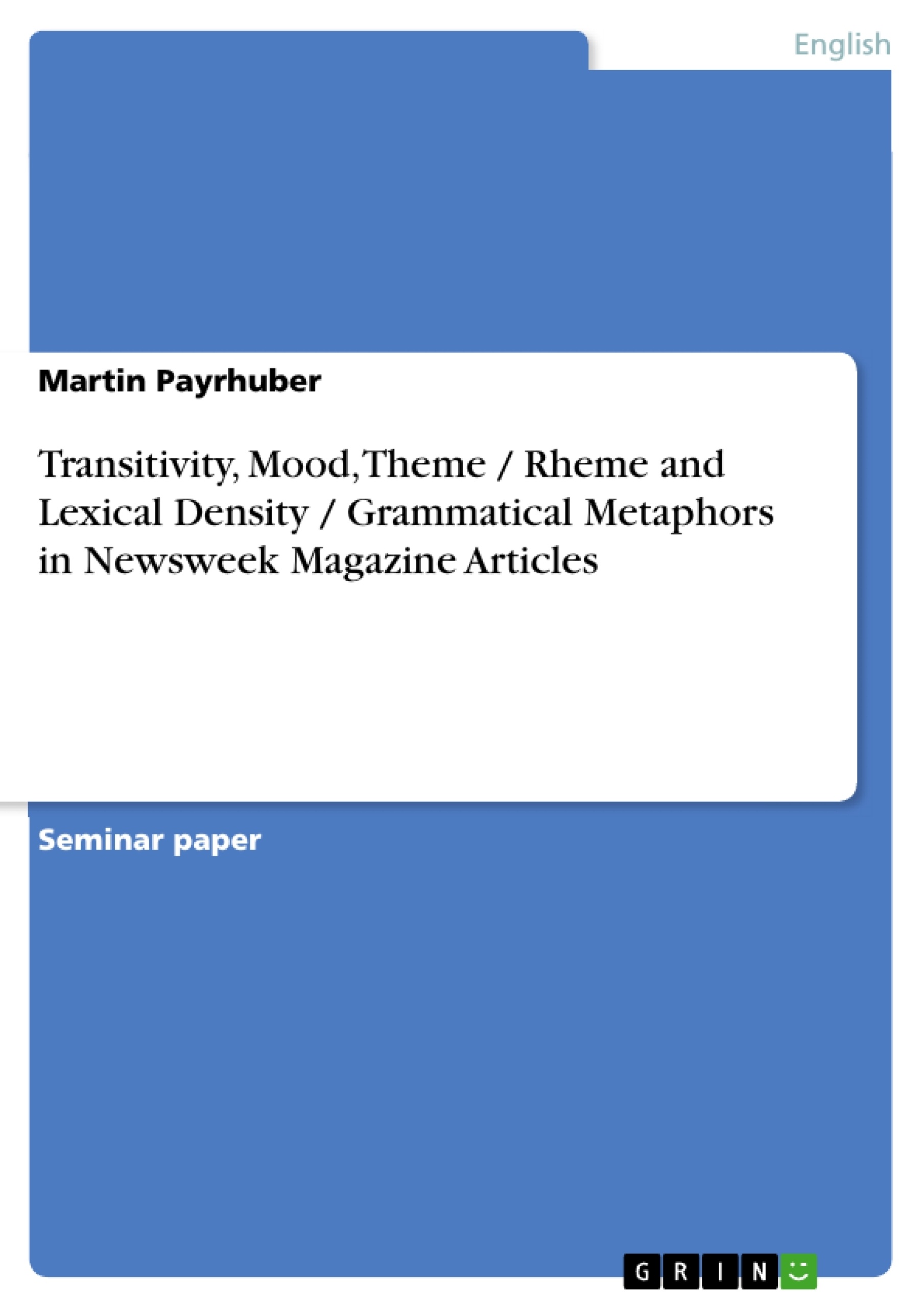Excerpt
1 Introduction
The main reason for Michael A. K. Halliday, the “father” of systemic functional linguistics – and this report is based on functional linguistic analyses – to develop a new kind of grammar was that he saw the need to have a linguistic system that is more sociological in orientation. While Noam Chomsky, the most prominent of the so-called formal linguists, saw linguistics only as a means to describe the limits of language, Halliday and his fellow functional linguists are concerned with relating language to society, they try to figure out how the ways in which language is used have shaped its structure.
My goal in this analysis was to relate language to society in a practical example, I have tried to explore the differences between two journalistic articles of the same magazine, but taken out of different departments as far as the content is concerned. My question was, “Are there substantial differences in language between these articles?”
2 Material Chosen
I have chosen two articles from Newsweek magazine, February 14th 2000, on a completely arbitrary basis. The only criterion for the sections of the articles chosen for analysis was that they had to contain about 100 words, for reasons of better comparability. The articles chosen are “Austria’s Power Player” , starting on page 14, and “Smooth as Santana”, starting on page 64. The first one is about Jörg Haider’s Freedom Party’s participation in the Austrian government while the latter one deals with the guitarist Carlos Santana’s continuing success in the world of Rock ‘n’ Roll. These articles stem from completely different sections in the magazine, one is about politics, the other one about show business. Thus, both articles are utterly suitable for an analysis of the language of different (lexical) fields.
3 Methods
The methods I have chosen for analysis are based on systemic functional linguistics theory and follow the analyses made in Martin et al. 1997, Working with Functional Grammar.
The first part of my analysis consists of exploring the basic categories of every research based on functional linguistics, the perspective of transitivity (experiential perspective), of mood (interpersonal perspective) and of theme / rheme (textual perspective). The second – and most important – part deals with a more specific part of functional grammar: the notions of lexical density and grammatical metaphors. In this respect, both articles were analysed according to three different methods of assessing the extent of lexical density:
Method A: the FOG Index developed in Ellis and Hopkins 1985: 35 – 36.
description: 1. take a sample passage of about 100 words
2. count the number of words in the sentences
3. divide the number of words in the passage by the number of sentences, giving the average length of sentence in the passage
4. count the number of words of three or more syllables in the passage
5. total the two factors just counted and multiply by 0.4 to obtain FOG Index
6. if the FOG Index is over 13, there’s “a danger level of reading difficulty”
Method B: Ure’s lexical density (LD)
description: number of lexical items x 100
total number of words
LD should not surpass 40 %, otherwise danger of reading difficulty
Method C: Halliday’s lexical density (LD)
description: “we will count the number of lexical items as a ratio of the total number of clauses. LEXICAL DENSITY will be measured as the number of lexical items per clause.” (Halliday 1985a: 67)
For scientific texts, Halliday’s LD should be about 6 or 7.
As an addition to “lexical density”, I have also analysed grammatical metaphors in both articles, since this is the second important factor that influences the readability of texts. In this respect, I have simply counted the number of so-called “thingifications” (grammatical metaphors), which means nominalisations that could also have been expressed by verbal groups, and compared them to each other.
Most of the analyses are presented in the so-called “box-format” demonstrated in Martin et al. 1997.
The analysis of theme / rheme is according to Halliday’s model, which means that “theme” is considered to be the beginning of the clause up to the first topical element in the clause and including it, not strictly up to the verbal element, as other scholars have argued.
4 Results
4.1 Analysis of Theme / Rheme
What is striking is that there is not a single interpersonal theme in either text, however, interpersonal themes are usually only popular in oral language, since the purpose of interpersonal themes is to rouse certain feelings in the listener. Therefore, the absence of interpersonal themes in the two articles is not surprising.
Another prominent result is the number of textual themes (6 in text B, only 2 in
text A), which might hint at a better structural coherence of text B.
4.2 Analysis of Mood
In both texts clauses appear almost exclusively in declarative mood (over 90 %), no questions are asked, no commands given. This is again due to the fact that the declarative mood is innate in written language, with the exceptions of rhetorical questions and commands.
[...]
- Quote paper
- Martin Payrhuber (Author), 2001, Transitivity, Mood, Theme / Rheme and Lexical Density / Grammatical Metaphors in Newsweek Magazine Articles, Munich, GRIN Verlag, https://www.grin.com/document/54755
Publish now - it's free






















Comments
IT'S GOOD